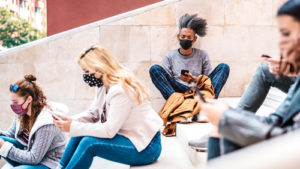One of the biggest challenges in reopening campuses is building and encouraging behaviors and habits that will keep students safe as the COVID-19 pandemic continues across the nation.
Research from the Societal Experts Action Network, an activity of the National Academies of Sciences, Engineering, and Medicine, has produced 15 recommended behaviors and actions that can keep students safe as they resume close-to-normal class attendance on college and university campuses.
The recommendations focus on habit-promoting strategies and communication strategies, and the strategies take several key factors into consideration:
• Many adolescents and young adults are socially driven, with a strong desire for reward and acceptance.
• Identity, agency, and autonomy are centrally important during the college years.
• College students are primed for exploration, and risk taking is a normative part of their development.
• Prosocial inclinations are strong among college-age students.
• Students can enhance the creation and implementation of policies that affect them.
Habit-promoting strategies to keep students safe include:
1. Make the behavior easy to start and repeat. People are more likely to behave in healthy ways when that behavior is relatively frictionless, meaning that it takes little time and effort to perform.
2. Make the behavior rewarding to repeat. Strategies for making protective behaviors rewarding are especially salient for adolescents and young adults because their motivational systems are reward focused.
3. Tie the behavior to an existing habit. People are more likely to repeat a behavior when they stack it onto an existing habit (a behavior they perform automatically).
4. Alert people to behaviors that conflict with existing habits and provide alternative behaviors. Because college students are inclined to exercise agency and autonomy, telling them only what they cannot do may lead to pandemic fatigue and associated risky behaviors.
5. Provide specific descriptions of desired behaviors. When individuals understand what specifically is expected of them, they are more likely to adopt the desired behavior.
Communication strategies to keep students safe at school include:
1. Use clear, consistent, and transparent messaging, with attention to mode of transmission. Clear messaging is important, and messages from different units on campus and city administrators should be accurate, consistent in content and tone, and transparent regarding procedures and data.
2. Avoid undue attention to the frequency of socially undesirable behaviors, instead emphasizing responsibility. Telling college students about the risks or prevalence of an undesirable behavior may actually make them more likely to engage in that behavior.
3. Foster efficacy and avoid fatalism, with attention to student agency. As adolescents and young adults are developing their sense of agency, they can be supported in making positive choices and effecting change by adopting protective measures.
4. Appeal to the collective good of one’s community, focusing on prosocial behavior and activism. Adolescence and early adulthood represent a time of opportunity. Prosocial behavior and student activism are common on college campuses.
5. Use trusted messengers, amplified by social media and other influencers. In addition to trusting their families, friends, and experts, younger students in particular are swayed by external influencers on YouTube, TikTok, Twitch, Instagram, Snap Chat, and other social media who could amplify messages from trusted experts.
6. Tailor the framing of the message to the audience, with attention to the risk–reward calculus. Adolescents engage in high-risk behavior on the basis of a cost/benefit analysis, whereas mature non-risk-taking young adults are more likely to take a gist-based approach that involves being aware of risk–reward trade-offs but leaning more on categorical (nontrade-off) thinking.
7. Link prevention behaviors to identities, with attention to campus affiliations. Because college is an important time for students to develop and explore their sense of identity, appealing to them as members of their college campus, dorm, major, fraternity, sorority, club, or team may be especially effective in establishing social norms.
8. Highlight social disapproval of a target audience member’s failure to comply when it occurs, without overemphasizing risk. While campuses need students to regard behaviors that can spread COVID-19 as socially unacceptable, they also need to be cautious about the emphasis they place on risk.
9. Highlight the growing prevalence of behavior change, using positive messaging. For college students, positive messaging can be more effective than a focus on negative behaviors or outcomes.
10. Avoid repeating misinformation, even to debunk it. Efforts to debunk misinformation can have the unintended effect of reinforcing false beliefs.
- First-generation students are more likely to seriously consider leaving college - April 17, 2024
- How higher ed can meet workforce needs - April 15, 2024
- Higher ed leaders believe continuing education units are undervalued - April 10, 2024

